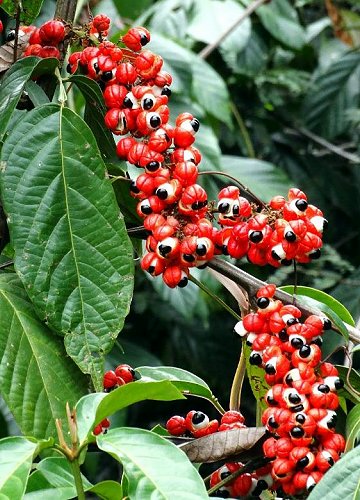
|
|
Guarana (Paullinia cupana).
Leaves and fruits.
|
Guarana - Paullinia cupana
Guaraná (Paullinia cupana, syns. P. crysan, P. sorbilis) is a climbing plant in the family Sapindaceae, native to the Amazon basin and especially common in Brazil. Guaraná has large leaves and clusters of flowers, and is best known for the seeds from its beans, which are about the size of a coffee bean.
Native to the Amazon, Paullinia cupana or commonly known as Guarana is an evergreen climbing shrub with tendrils growing about 13m in height. When growing in the forest it can reach up to the canopy, but is less vigorous when growing in a sunny position. It has large leaves with five leaflets each
leaf and, when tendrils exist, they are axillary.
Flowers are small white in clusters. Inflorescences on axillary racemes or originate on the tendrils. Flowers male and female, zygomorphous and have five petals and sepals,
eight stamens and a trilocular ovary with a glandular semi-disc at the base.
Fruit pear shaped, orange-red, and 3 sided with three-celled capsules,
partially open when ripe, revealing 1-3 black or greenish seeds which are covered at the base with a white aril.
The color contrast when the fruit is split open has been compared with the appearance of eyeballs, and has become the basis of an origin myth among the Sateré-Mawé people.
The word guaraná has its origins in the Sateré-Maué word for the plant, warana.
The name 'Guaraná' comes from Guaranis, a tribe of South American
Indians. The genus name, Paullinia was taken from a German medical botanist, C.F. Paullini, who 'discovered' the plant.
Guaraná plays an important role in Tupi and Guarani culture. According to a myth attributed to the Sateré-Maué tribe, guaraná's domestication originated with a deity killing a beloved village child. To console the villagers, a more benevolent god plucked the left eye from the child and planted it in the forest, resulting in the wild variety of guaraná. The god then plucked the right eye from the child and planted it in the village, giving rise to domesticated guarana.
The Guaranis make a herbal tea called cupana by shelling, washing and drying the seeds, followed by pounding them into a fine powder. The powder is kneaded into a dough and then shaped into cylinders. This product is known as guaraná bread, which is grated and then immersed into hot water along with sugar.
This plant was introduced to European colonizers and to Europe in the 16th century by Felip Betendorf, Oviedo, Hernández, Cobo and other Spaniard
chroniclers. It has since been used, refined, adapted and commercialized by settlers, folklorists, food scientists, and marketers.
Guarana is known for its large and black seeds, which contain high concentration of caffeine.
The roasted and pounded seed is made into a paste which is then used to make a stimulating beverage that is rich in caffeine. The sweetened paste, called Brazilian chocolate, is used in soft drinks, candy etc. The seeds contain 2.7 - 7% caffeine as well as the stimulants theophylline and theobromine. The seeds contain up to 7% of a caffeine-like compound known as guaranine, which is not addictive and takes longer to be metabolized, giving it a gentler, more sustained stimulating effect. The seeds are also roasted, pounded, and used as a flavouring in bread.
Guarana seed contains xanthine derivatives, including up to 7% caffeine plus theobromine and theophylline; tannins and saponins. It is an astringent, bitter, diuretic herb with a strong, stimulant effect. The seed is said to be antipyretic, antineuralgic and antidiarrhoeal, and is also reputed to be a powerful stimulant, an analgesic comparable to aspirin and an anti-influenza agent. The Rainforest tribes have used guarana mainly as a stimulant, astringent and in treating chronic diarrhoea. The powdered seed is taken internally to relieve fatigue, aid concentration and lift the spirits. One report says that overuse can cause sleeplessness, although less so than caffeine-based drinks, whilst others say that the stimulating effect is due to caffeine. A useful short-term remedy for boosting energy levels, though it tends to inhibit the body's natural restorative processes if used in the longer term. The seed is also taken internally in the treatment of chronic diarrhoea; headaches and migraine; and in the treatment of mild depression.
Guaraná is used in sweetened or carbonated soft drinks and energy drinks, an ingredient of herbal teas or contained in dietary supplement capsules. South America obtains much of its caffeine from guaraná.
Brazil, the third-largest consumer of soft drinks in the world, produces several soft drink brands from the seeds of guaraná. A fermented drink is also prepared from guaraná seeds, cassava and water. Paraguay is also a producer of guaraná soft drinks with several brands operating in its market. The word guaraná is widely used in Brazil, Peru and Paraguay as a reference to soft drinks containing guaraná extract.
Source:
https://en.wikipedia.org/wiki/Guarana#
https://pfaf.org/user/Plant.aspx?LatinName=Paullinia+cupana
https://apps.worldagroforestry.org/treedb/AFTPDFS/Paullinia_cupana.PDF
